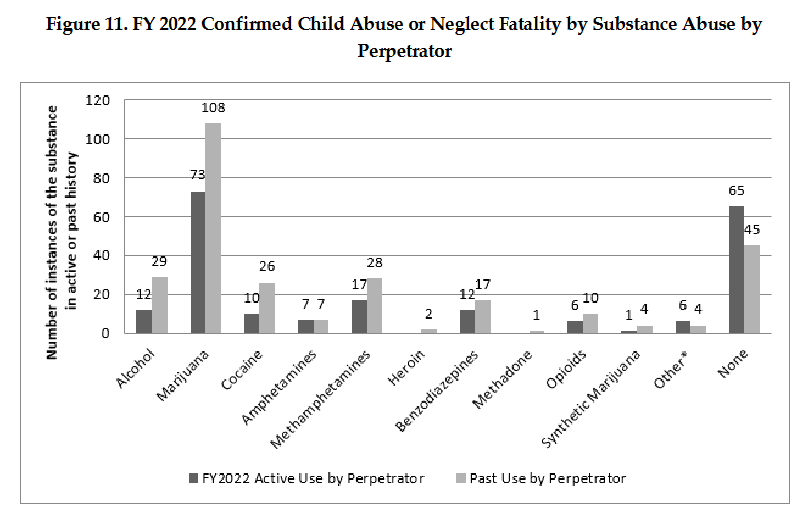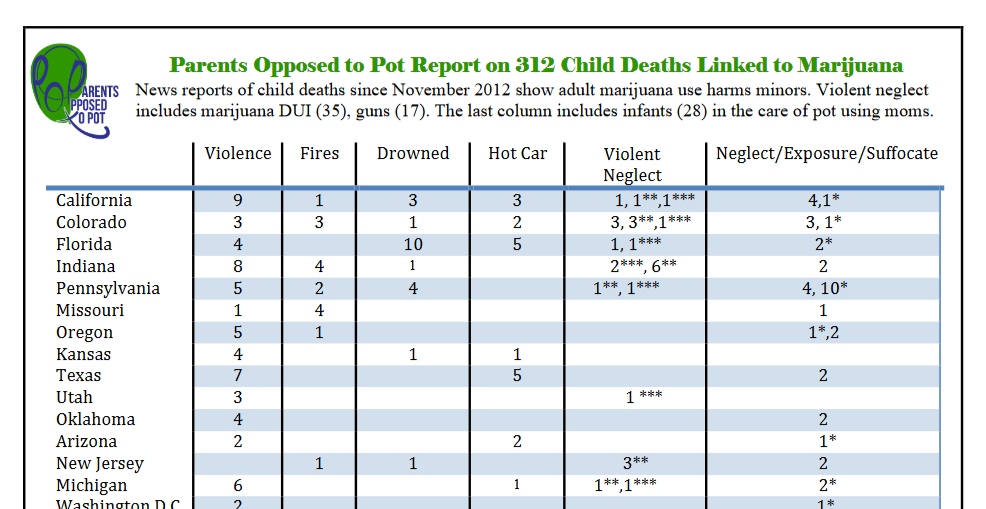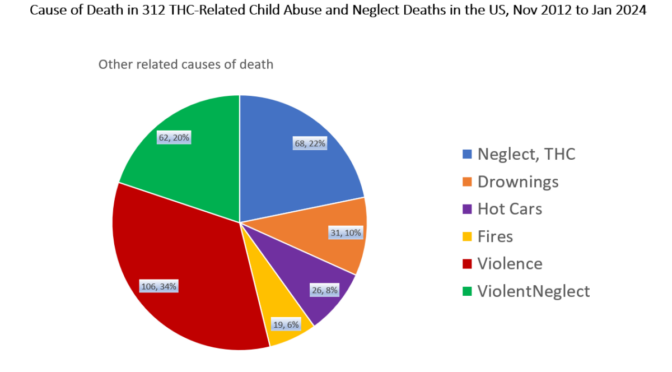As of January 2024, we’ve tracked 312 child abuse deaths related to cannabis in the United States over the past 11 years. Our data comes mainly from news stories found online. Where are the academic researchers who should be studying this problem?
In three states that track substance use in reports of child abuse — Arizona, Florida and Texas — marijuana is most frequently listed.
Our count begins in November 2012, when the first two states, Colorado and Washington, voted to legalize pot .Legalizing marijuana sends an underlying message, ‘If it’s legal, it must be safe’; we suspect the number is much higher.
When recreational pot shops opened in January 2014, the Colorado news media reported on three pot-related child deaths. Pro-pot activists wondered if it could dampen public opinion of legalizing pot, but national media chose not to report it.
Using Texas to typify what happens
Although a new report should be released any day, we share the chart from the report from Texas in 2022.  Of 182 child abuse or neglect deaths in 2022, 73 of the perpetrators were active marijuana users at the time, 40 percent. Fifty-nine percent were former marijuana users. Texas includes unsafe sleeping as a factor in death, as it contributes to about 30 -50 deaths per year. Education on child safety and not using drugs would reduce that number. Texas has made admirable attempts to bring down the number of child deaths, but 60 to 75 percent of reported deaths over several years involve substance use.
Of 182 child abuse or neglect deaths in 2022, 73 of the perpetrators were active marijuana users at the time, 40 percent. Fifty-nine percent were former marijuana users. Texas includes unsafe sleeping as a factor in death, as it contributes to about 30 -50 deaths per year. Education on child safety and not using drugs would reduce that number. Texas has made admirable attempts to bring down the number of child deaths, but 60 to 75 percent of reported deaths over several years involve substance use.
Texas is the second most populous state in the union; we believe its stats would be similar throughout the country.
Why is this the case? Here are some observations:
1) Marijuana is the “care-less” drug. Marijuana users can become disengaged from their environment, and they tend to have poor executive functioning. They also lose track of time and become forgetful. Marijuana use by parents who forgot about their infants and toddlers was reported in about 6 percent of the hot car deaths in the USA since 2012. With today’s high-potency cannabis, parents who use it may be impaired or pass out for hours.
2) Marijuana has been mischaracterized as a drug that always calms people, unlike alcohol which allegedly is more likely to stimulate anger. Calming effects only last so long. Once addiction takes over, marijuana users have withdrawal symptoms and can experience extreme anxiety attacks that stimulate anger. Plus the drug is very idiosyncratic and it affects different people very differently.
3) Marijuana causes paranoia in a significant percentage of the population. When the paranoia becomes extreme and takes the form of hallucinations, violence can erupt. A large portion of parents who attack their children while on marijuana were experiencing cannabis-induced psychosis.
4) The use of cannabis is normalized and promoted in the United States. The data we’ve collected shows that both cannabis-induced psychosis and prenatal cannabis use leading to infant deaths are on the rise. At first, we only read about drownings, fires and hot car deaths related to parent pot use. Now it’s suffocation and violence.021424-Child-dangers-fact-sheet-FINAL 
Statistics on Child Abuse and Neglect Deaths
An estimated 1,990 child abuse deaths occurred in the United States in 2022. By law, each state is required to compile reports on child abuse. These figures seem to be rising since legalization:
2011 1,570 *
2012 1,630
2013 1,550
2014 1,590
2015 1,680
2016 1,750
2017 1,765
2018 1,825
2019 1,850
2020 1,830
2021 1,930
2022 1,990
Reports of child abuse went up during COVID-19 in 2020, but the actual number of deaths went down rather than up.
International studies show that between 60 and 70 percent of child abuse and neglect incidences are related to drug and alcohol use. Substance use and substance abuse are more significant than poverty, stress and mental illness when it comes to child maltreatment. “Though child welfare advocates and policymakers often claim that maltreatment stems from factors beyond parents’ control, most Americans disagree,” writes Naomi Schaefer Riley.
What is required in state reports?
The CAPTA Act, last revised in 2016, requires states to have procedures in place to protect children from multiple forms of child abuse and neglect, including sexual abuse and trafficking. CAPTA stands for the Child Abuse Prevention & Treatment Act, which first passed in 1973.
Only 5 states mandate reporting when substance abuse is suspected by pregnant women, so that mothers may be referred to services. These moms need help and drug treatment, not punishment. In 26 states, health-care providers must report when they treat infants who show evidence of having been exposed to drugs. However, only 23 states include prenatal exposure to controlled substances in the definition of child abuse or neglect.
An academic researcher should gather all the state data and report to Congress on the substances related most closely to child deaths. Let’s get real and work to prevent marijuana and other drug abuse by parents. We want safe children and to avoid the tragedies reflected in this data.
* These numbers come from Child Maltreatment reports put out by the Department of Health and Human Services over the last 10 years. The format is similar to the one mentioned above. The report of 2022 was published in January, 2024. Most of this information can be found online.

